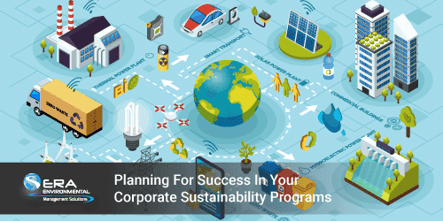 If you’re an EH&S Manager and you have a big sustainability project looming on the horizon, ERA has important advice for you: start planning now!
If you’re an EH&S Manager and you have a big sustainability project looming on the horizon, ERA has important advice for you: start planning now!
Managers and practitioners alike often underestimate how long it takes to design a functioning long-term plan. To quicken the process, they come up with projects that are either too insubstantial or complex for executives to buy into and finance.
To avoid this possibility, ERA has taken the time to research and put together an outline of the essential bases you must cover when developing your corporate sustainability strategy. While it’s not exhaustive, it should give you a good overview of how and where to start planning for success, so that you may guide your business toward a greener future in a feasible way.But first, What is a Sustainability Program?
There are as many definitions as there are programs themselves. At its core, however, a Corporate Sustainability Program/Plan/Project (CSP) is a way of doing business that prioritizes the environmental and social dimensions of your company’s work as much as the creation of stakeholder value. In a way, it is an extension of the Triple Bottom Line, in that you implement a CSP if you want your business to generate profit without compromising the well-being of the environment and the people (of today and tomorrow).
It makes sense, then, that the three pillars of corporate sustainability are the environmental, the economic, and the social. A big part of carrying out a CSP is thinking about your business’ footprint and how to reduce it, promoting sustainable practices to that effect, engaging the community and giving back to it, and ultimately aligning your expenditure with these values. Develop a CSP that does not address all the pillars and you are bound to clash heads with those who prioritize the ones you're leaving out.
Now that you see the big picture, we can jump into the particulars. Keep in mind that every business is different and that no two CSPs are the same; think of the following as a list of recommendations, rather than a step-by-step guide.
How to Start Your Corporate Sustainability Program
Identify the Key Areas
There are only so many changes your future budget will allow for. Your task when planning a sustainability program for your business is identifying its core issue(s) and selecting policies that address it.
The following are some of the most common areas of improvement:
- Water use (consumption, irrigation, leakage)
- Energy use (renewable vs fossil fuels, heating, lighting)
- Transportation (operations and employee travel)
- Waste (hazardous vs non-hazardous, recyclable waste, reusable alternatives)
- Supply chain (environmentally friendly suppliers, green procurement)
- Food (sourcing, composting)
- Buildings (heating, lighting, energy efficiency)
How many areas you pick depends entirely on your business model. For example, if most of your company’s footprint stems from waste generated at the final product stage, say, by producing a high quantity of landfill-bound plastic, it might be a good idea to zero in on finding an alternative material or new recycling opportunities. Even if they take a long time to research and implement, changes like these tend to have a huge effect on your sustainability score.
You can then complement these changes with less complicated ones—in line with the example, something like replacing water bottles in the office for reusable ones… which takes us to our next point.
Prioritize Practical Sustainability Initiatives
At the end of the day, what matters is that your CSP is practical enough to generate change. Sometimes, the easy wins are the best place to start: they can result in the kind of disproportionate positive impact that builds the momentum needed for the bigger projects.
Transitioning to renewable energy across your entire supply chain overnight is practically impossible, and the plan to divest from fossil fuels is often met with significant pushback. That said, few people would be opposed to installing energy-efficient appliances throughout their facilities or offsetting their emissions by investing (a reasonable sum) in carbon emission reduction projects (such as sponsoring renewable energy suppliers). With these initiatives, you can achieve significant savings/reductions and through them justify further contributions to your CSP.
Here are a couple other sustainability initiatives you can ‘easily’ implement in the workplace:
- Water: installing low-flow faucets (also known as faucet aerators)
- Transportation: transitioning to a hybrid work model (if not to a work from home model) and encouraging the use of public transit (if possible)
- Waste: conducting a solid-waste assessment and looking into local recycling centers
- Supply chain: procuring office supplies from local sources and made from recyclable or biodegradable materials
- Food: segmenting your waste and composting food scraps
- Buildings: installing programmable thermostats, LED lights, and/or solar panels on the roof
Any CSP will include a number of these initiatives, but beware of filling it with quick fixes: sustainability is about making a (rewarding) sacrifice, not checking boxes as quickly as possible.
The lesson here is to strike a balance between a few, meaningful policies that are hard and costly to implement with a handful of relatively easy and cheap ones that yield minimal improvement.
Write your Sustainability Strategy's Mission Statement
Now that you’ve determined which projects to tackle, the next step is getting people involved. To do so, you must have a concise resource they can refer to for an understanding of what your CSP is aiming to achieve, how it will be done, and why that makes the company more environmentally responsible than it was in the past.
You can use company’s overarching mission statement as the template for your sustainability plan’s goal. Think about the sustainability initiatives you are proposing and how they are part and parcel of your company’s ability to meet its mission. Not only does that bolster your argument, but it also puts the organization’s green values in a context that matters to its stakeholders, raising the question as to what the company will look like in the future.
With that terminology in mind, outline the changes you hope to make and define when one can realistically expect them to be put in place. You’ll want to set a specific time frame; after all, this estimate will form the basis of your long-term goals, which need to be gradual and quantifiable if you are to measure the success of your corporate sustainability program. In most cases, it’s best to start small and plan for the snowball effect.
If you’re struggling to get the mission statement underway, we recommend checking out the Green Business Bureau’s guide.
Win Executive Buy-in
To put your plan into practice, you’ll need to convince the executive decision-makers to provide you with a workable budget. This is easier said than done; their priorities do not always match yours. One way to work around this issue is to frame your CSP in terms the executive team understands and values, which usually means proving the project will save the company money in the long run.
To that end, use the goals you outlined in the previous steps to determine a measurable return on investment (ROI). Estimate the initial cost and any foreseeable overhead, then show how the project’s monetary ROI will improve your bottom line. This can be difficult when the intent of your CSP is to reduce greenhouse gas emissions or to apply the voluntary Global Reporting Initiative (GRI) framework, two efforts that are not designed to generate revenue.
That’s why it’s important to leave room for the secondary, indirect benefits. The executives may not care about how much a new boiler will reduce hazardous air pollutants, but they will pay attention to the savings in fuel purchases. A sustainability program will inevitably eat up a portion of the employees’ time, but if they’re engaged and feel that their work matters, it might improve their morale and influence their decision to stay with the company long term.
In other words, there are various angles to take when justifying your sustainable business practices. The environmental is only one of them.
Assessing Your Corporate Sustainability Goals
Once you have a budget and the go-ahead, it’s time to put the plan in motion. Depending on the type of project you are undertaking, this will take on different forms. Check out these articles to find tips on a range of corporate sustainability programs, or schedule a consulting call with a project analyst below.
- Are you looking for better chemicals/materials to use that will reduce air emissions and waste?
- Are you looking to improve your compliance reporting and get more efficient?
- Do you want to cut costs associated with treating or shipping waste?
- Is implementing sustainability reporting your goal?
If all else fails and you have doubts left regarding your sustainability plan, refer to our 5-part series of blogs on going beyond compliance or our guide on implementing a successful environmental management system. You will most likely find the answer you are looking for in one of these resources.
This Blog Was Co-Authored By:



December 13, 2012


Comments